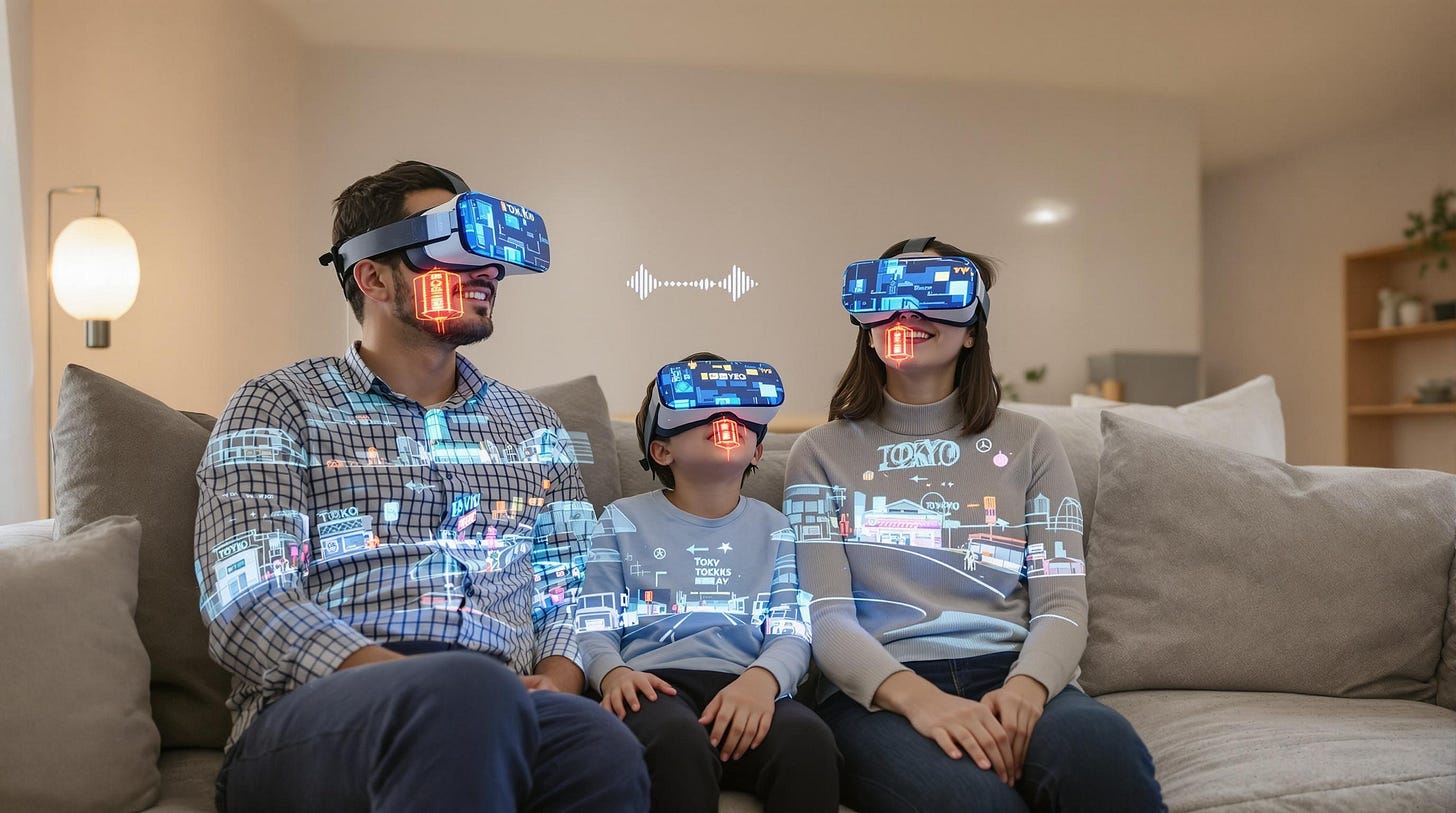By 2030, We Stopped Traveling. Travel Came to Us.
When AI, mixed reality, and hyper-connectivity made ‘being there’ a choice, not a necessity.
By 2030, travel was no longer defined by distance. The planes, trains, and long-haul flights that once represented exploration had become optional. Instead, the rise of AI and mixed reality brought the world to us, wherever we were.
Imagine walking through the vibrant streets of Tokyo without leaving your living room. Through sleek, AI-enhanced mixed reality headsets, not only could you see the lantern-lit alleys of Shinjuku, but you could hear the hum of the crowds, smell sizzling yakitori, and feel the texture of a hand-painted kimono. Travel was no longer about the journey; it was about immersion.
This transformation didn’t happen in isolation. By the late 2020s, AI had already revolutionized industries, and its foray into travel was inevitable. At first, augmented reality tours of historic landmarks gained popularity, but by 2027, platforms like WanderAI and RealScape VR introduced full-scale sensory travel experiences. By 2030, travelers faced a choice: pack a suitcase or power up a headset.
The Shift: Convenience Over Curiosity
The pandemic of the early 2020s laid the groundwork for this shift. As lockdowns made physical travel impossible, virtual alternatives emerged out of necessity. But once the world reopened, the convenience of virtual exploration proved hard to let go. Why spend hours in transit or thousands of dollars on plane tickets when AI could deliver a comparable experience in seconds?
The rise of “immersive tourism” was fueled by relentless innovation. AI analyzed user preferences to tailor experiences, ensuring every virtual journey felt personal. Mixed reality environments blended with real-time AI inputs created moments so authentic they were indistinguishable from reality. A weekend escape to Machu Picchu? Now, it was just a subscription away.
The Corporate Revolution
While leisure travel adapted, business travel virtually disappeared by 2029. Companies eager to cut costs embraced AI-driven holographic meetings. Executives could “attend” conferences on multiple continents in a single day without leaving their office chairs. Hyper-realistic holograms powered by AI not only replicated presence but adjusted their behavior to suit cultural nuances, transforming the very fabric of corporate engagement.
For airlines, this marked an existential crisis. Business travelers, their most profitable customers, had evaporated. In response, carriers pivoted to offering hyper-luxury experiences, branding themselves as curators of the “true travel” experience. But even these efforts couldn’t offset the tidal wave of change.
Winners and Losers
Winners:
Tech Innovators: Companies like MetaJourney and Virtual Horizon emerged as leaders, dominating the burgeoning immersive travel market. Their AI-powered platforms delivered hyper-personalized adventures, sparking a new age of digital exploration.
Everyday Travelers: With costs slashed and accessibility widened, millions who had never traveled internationally could now experience the world in vivid detail.
Losers:
Tourism-Dependent Economies: Physical tourist hotspots faced steep declines as visitors shifted to virtual alternatives. Local economies struggled to replace the revenue lost from virtual travelers who contributed nothing to on-the-ground spending.
Airlines and Hotels: These industries saw unprecedented declines, forced to restructure or pivot entirely to survive in a world where long-haul travel was no longer the norm.
The Emotional Divide
Despite its promise, virtual travel sparked fierce debate. Advocates celebrated its inclusivity and efficiency, but skeptics argued that something intangible was being lost. By 2029, the “True Travel” movement had gained momentum, with proponents advocating for the raw, unfiltered experiences that only real-world exploration could provide.
“No simulation can replace getting lost in a foreign city or sharing a meal with strangers,” said one activist at a 2029 rally. “Travel is about more than sights. It’s about connection.”
In response, boutique travel agencies began offering curated, technology-free adventures. Dubbed “Analog Escapes,” these trips catered to those seeking genuine, tactile experiences—no headsets, no AI, just the unpredictable beauty of the real world.
Looking Ahead: A New Era of Exploration
By 2030, travel had been redefined. AI and mixed reality had made the world more accessible than ever, breaking down barriers of cost and geography. Yet, the growing backlash highlighted a deeper question: What do we really seek when we travel?
For some, it’s the convenience of curated perfection, the ability to visit distant lands without the discomfort of jet lag or language barriers. For others, it’s the unpredictability of the journey itself—the moments that can’t be planned or simulated.
The future of travel remains uncertain, but one thing is clear: by 2030, the question was no longer how we travel, but why.
[Image credit: AI Brand Photographer at FOMO.ai. FOMO.ai gets brands more traffic.]




